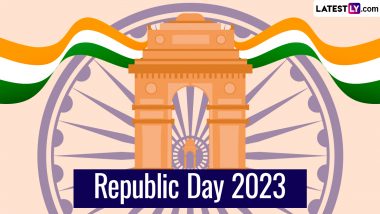India is gearing up to celebrate its 74th Republic Day on January 26, 2023. As we near the day, let us revisit the history of the tricolour, also popularly known as ‘Tiranga’. On this Republic Day, let’s take a look at the history of tricolour and its evolution over the years. The national flag of India is a symbol of the country’s freedom from British rule. The present form of the National Flag was adopted a few days before the country gained independence from British rule on August 15, 1947. The decision to adopt the national flag was made during the meeting of the Constituent Assembly held on July 22, 1947. The national flag has evolved over the years and has seen a lot of changes before arriving at what it is today. Republic Day 2023 Office Bay Decoration Ideas: Get Simple and Quick Designs To Jazz Up Your Workplace With the Spirit of Tricolour (Watch DIY Videos).
Here Are 10 Interesting Facts About the Indian Tricolour
- The first unofficial flag of India was hoisted on August 7, 1906, in the Parsee Bagan Square (Green Park) in present Kolkata. It featured three horizontal stripes of red, yellow and green.
- The second flag, which was very similar to the first one, was hoisted in Paris by Madame Cama and her band of exiled revolutionaries in 1907. However, the lotus was replaced by stars which denoted the ‘Saptarishi’.
- During the Home Rule Movement, Dr Annie Besant and Lokmanya Tilak hoisted the third flag in 1917. The third flag was very different from the first two as it had red and green horizontal stripes, seven stars in the 'saptarishi' configuration, the Union Jack, and a white crescent and star. Republic Day 2023 Rangoli Designs: Beautiful and Unique Rangoli Patterns for Home or Workplace.
- The fourth flag was unofficially adopted in 1921. As per records, a youth from Andhra Pradesh named Pingali Venkayya designed a flag and took it to Mahatma Gandhi during an All India Congress Committee meeting. The flag had red and green, which represented the Hindu and Muslim community in India. Gandhiji added the white strip to represent the other communities in the country and the spinning wheel to symbolize the nation's progress. Hence, Pingali Venkayya, a freedom fighter from Andhra Pradesh, designed the National Flag of India.
- According to the law, the National Flag of India is to be made by ‘Khadi’, which is hand-spun wool/cotton/silk Khadi cloth. Karnataka Khadi Gramodyoga Samyukta Sangha is the only unit in India that is accredited to supply and manufacture the Flag of India.
- The manufacturing right to make the National Flag of India is owned by The Khadi Development and Village Industries Commission.
- The Tiranga comprises three colours and Asoka Chakra in its middle. The Saffron colour represents courage and sacrifice, white stands for truth, peace, and purity, the green colour signifies prosperity, while the Ashoka Chakra represents the Laws of Dharma.
- Dharma Chakra depicts the "wheel of the law" in the Sarnath Lion Capital made by the 3rd-century BC Mauryan Emperor Ashoka.
- The year 1931 was a landmark in the history of the flag as a resolution was passed adopting a tricolour flag as the national flag of our country. This flag had saffron, white and green colours, like the present flag and a spinning wheel at the centre. On July 22, 1947, the Constituent Assembly adopted it as Free India National Flag.
- The largest Indian flag was hoisted on Indo-Pak Attari Border, which measured 110 meters in length, 24 meters in width, and 55 tons in weight.
As you can see, the evolution of the flag has had a very interesting history. We wish you all a very Happy 74th Republic Day of India!
(The above story first appeared on LatestLY on Jan 25, 2023 08:08 AM IST. For more news and updates on politics, world, sports, entertainment and lifestyle, log on to our website latestly.com).













 Quickly
Quickly











